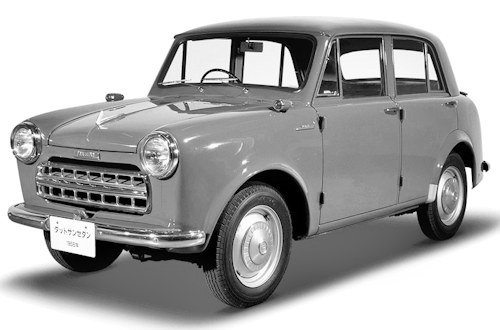Datsun 110/112/113
 |
|
|
Make: |
Datsun |
|
Production period: |
1955-1957 |
|
Class : |
small car |
|
Body versions : |
Sedan , station wagon , convertible sedan |
|
Engines: |
Petrol :0.86 liter (18 kW) |
|
Length: |
3860 mm |
|
Width: |
1466 mm |
|
Height: |
1540 mm |
|
Wheelbase : |
2220 mm |
|
Curb weight : |
880-890 kg |
The Datsun 110 series is a range of compact cars that Datsun produced from 1955 to 1957 as the successor to the Datsun DS series and as the 110/112/113 .
History
The Datsun 110 from the series also the pickup Datsun 120 was derived, which was also modernized parallel to the reworkings of the 110. The 110 model series was the forerunner of the 210 Bluebird . While the predecessor chassis was still supplied by Mitsubishi Heavy Industries to Datsun, Datsun built the 110 now completely himself.
In January 1955, the production of the model 110 began as a five-door sedan and station wagon W110, which was also built as an ambulance , at the same time launching competition model Toyopet Crown . A little later, the pickup Datsun 120 and the model K110, a sedan with convertible top.
The drive took over the water-cooled inline four-cylinder D10 with 860 cc and 25 hp, which was developed before the Second World War . The chassis produced the little north Nissan -Werk in Kantō . The design, which was based on Austin Motors models, was very modern at that time, especially compared to its predecessor. The dashboard had a central instrument cluster with speedometer, tank and temperature display and the entire on-board electronics consisted of a 6-volt power supply. The grille consisted of two large horizontal chrome strips. In the radiator grille, the turn signals were mounted and on the back were two tall and narrow oval tail lights.
In December 1955, the 112 replaced the 110. The situation of the instrument cluster was changed, which now sat directly in front of the driver and there were now round taillights. The front turn signals were now sitting on the fenders almost directly in front of the windscreen. The grille now consisted of two horizontal rows with eight rectangular slots and a large horizontal bar in between. The technology remained completely unchanged, in the model variants, there was now also a two-door station wagon, while the convertible was no longer available. The Datsun 112 won the second Mainichi Industrial Design Award in 1956 for its novel design, maneuverability and comfortable interior.
As early as May 1956, the 113 replaced the 112 and was built until September 1957. The only change was the transmission. So far, a 4-speed gearbox produced by Austin Motors from the Austin A40 Somerset was used under license . Now a self-developed 4-speed gearbox with synchronized 2, 3 and 4-speed has been installed. In Asia , a steering wheel circuit was a great advantage, as it offered the possibility of installing a front triple seat. This was realized at 113. Due to the changes, the weight dropped by 10 kg and at the same time a new vehicle floor was introduced with now less transmission tunnel.
From October 1957 the Datsun 210 Bluebird was introduced, which is based on the 113. The actual successor was the Datsun 114 , a cheaper version of the 210.
